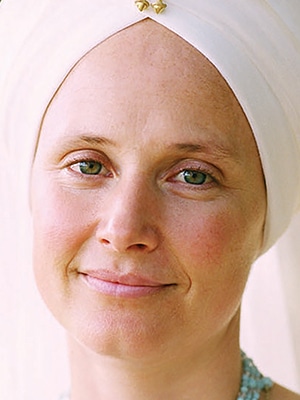- LIVE ONLINE PROGRAM
December 3-5, 2022
Regulate Your Nervous System with Yoga Practices
Fundamental Tools of Medical Yoga
Mala Cunningham
4 DAILY SESSIONS, 12:00-1:30pm ET
Course Description:
Within all of our hearts, there exists a quiet, peaceful space naturally. Yet, we often carry and hold the baggage of past actions, future worries, and imaginary fears in that space instead. This creates an incredible amount of noise, pain and contraction in our lives that is ultimately 100% unnecessary.
In this program Snatam and Sopurkh will share tools of Nada Yoga, otherwise known as the Yoga of Sound, a practice that involves vibrating divine sound within us and then projecting it outward. When you are taught to tap into your inner well of power, the practice of Nada Yoga originates effortlessly. It evolves deep within the quiet space in the center of every human being and produces a sacred sound known as the “Anahat”.
The Anahat can be defined as the unstruck sound; it finds its way through our thoughts, our words, our actions, our chants, and our songs. It is everywhere, underlaying all things—once we are taught to be aware of it, to seek it out, we can use it to bring clarity where we need it most, to bring healing to the wounds that are constantly wearing away at our ability to perform and experience life fully, and to cleanse and purify the passageways within us that are blocked and stopping us from finding joy in every crevice of mundane life. This sacred sound cuts through the illusion of the world like the sword of a fierce warrior. This sound heals us with its energy of pure love so that we may truly experience peace in our hearts.
In this workshop we will practice Kundalini yoga, chanting, and meditation. Please make sure to wear comfortable clothing, bring a water bottle, and have a mat to practice yoga on.
What you'll learn:
- How to release emotions through chanting
- How to foster concentration and create one-pointedness in the mind
- Stress management through devotional singing
- Increasing positive mood, feelings of relaxation and focused attention
- Promote internal self-healing on spiritual, mental, physical, and intellectual levels with communal and individual chanting practices
What is Nada Yoga? What is kirtan?
What is Nada Yoga? In Sanskrit, Nada means sound; yoga means union of. Therefore, Nada Yoga is quite literally the process or act of seeking unification through the use of sound. The unification of what? The unification of the outer self or outer identify with the inner self or inner identity; the unification of all things within you that feel at a disconnect with each other. Nada Yoga’s aim is to help you cultivate a state of mind that is peaceful and full of love. By practicing Nada Yoga, we creative rituals that allow us to slip into that space of pure concentration, focus, love, and joy at a moment’s notice.
What is kirtan? Kirtan is derived from the Sanskrit root meaning to call, recite, praise, or glorify. Put simply, it is the act of praising and glorifying some form of divinity. Kirtan involves joyous chanting often performed in a community environment with the accompaniment of instruments such as the harmonium, tabla, and cymbals.
The resurgence of kirtan in the 20th century in the East coincided with a renewed zeal or focus being placed on Bhakti yoga, the yoga of self-surrender and devotion. Swami Sivananda, one of India’s modern sages, did much to reignite the fire of kirtan in India by going from town to town and vigorously leading the entire town’s population into chants that lasted days. Since the mid-20th century, kirtan and the chanting of mantras has found its way to the West. Many find the chanting of mantras appealing because it doesn’t require intense focus and is often done in a collective environment that is supportive and uplifting.
What are the benefits of kirtan, chanting mantra, and other practices of Nada Yoga?
Chanting mantra has been shown to reduce anxiety, depression, dependencies and many mental ailments. The Alzheimer’s Research & Prevention Foundation recommends the chant Saa Taa Naa Maa for improving memory, developing greater attention, concentration, and focus, and bettering the mood. Other research studies also showcase the benefit of chanting for chronic pain conditions.
The practice of kirtan or chanting mantra regularly has been shown to bring our bodies back into balance, promoting holistic wellbeing: mental, intellectual, physical, emotional, and spiritual. Chanting helps us regulate our sleep, energy input and output, and, thanks to the stimulation of the vagus nerve, the “rest and digest” response of our bodies which is also responsible for regulating breathing, heart rate, muscles, digestion, circulation, and even the vocal cords. Simply put, chanting helps slow down the heart rate, lower blood pressure, relax different muscles and produce slow, regular, and deep respiration.
Additional Information:
Offered as 4 daily sessions on December 20, 21, 22, and 23 from 12:00-1:30pm ET.
This program is offered live through Zoom webinar with the availability for students to interact through Q&A with the presenter.
For enrolled students, a video recording will be available after each class in the event you miss a class or would like to review the content.
Recommendations:
- Viewing Device: Desktop or laptop computer will provide the best experience, although you can also connect via a tablet or smartphone.
- Internet connection: High-speed broadband wired or wireless is best.
- Video: Download Zoom to your computer, or install the Zoom app to your device. For interactive group sessions, a webcam or integrated camera will allow others to feel more connected with you.
- Audio: Headphone speakers are recommended. If you wish to participate vocally, a headset with a microphone will be ideal.

Snatam Kaur
Snatam Kaur is an American kirtan singer and peace activist, who learned to sing in the Sikh musical style with her mother. One of the most popular New Age artists of our time, she has been recording music since 2000; Her best-known CDs include Shanti, Grace, and Liberation’s Door. Her music can be heard around the world in venues from yoga studios to schools to Hollywood films and in the homes of her fans worldwide. Snatam Kaur has an amazing ability to transform traditional chants into a contemporary sound that appeals to the modern ear and awakens an ancient yearning in the soul. While traveling the world on tour she also teaches yoga and meditation to children and adults alike, a part of her commitment to give people tools for a daily experience of inner peace.

Sopurkh Singh
Sopurkh Singh began studying Kundalini Yoga and Meditation with his teacher Yogi Bhajan in 2000. He now teaches retreats, workshops and classes all over the world with his wife, Snatam Kaur.
